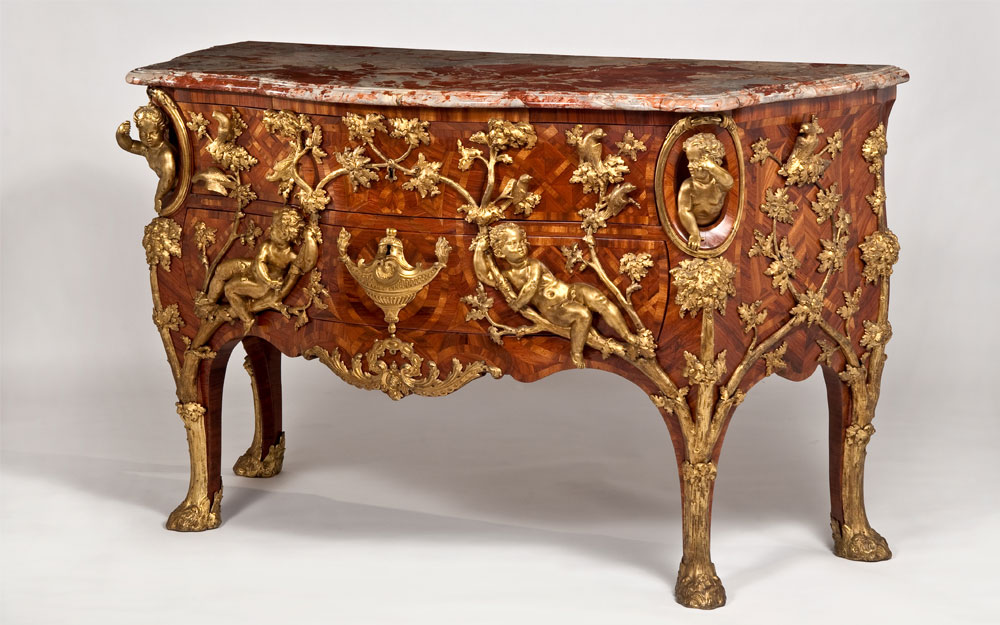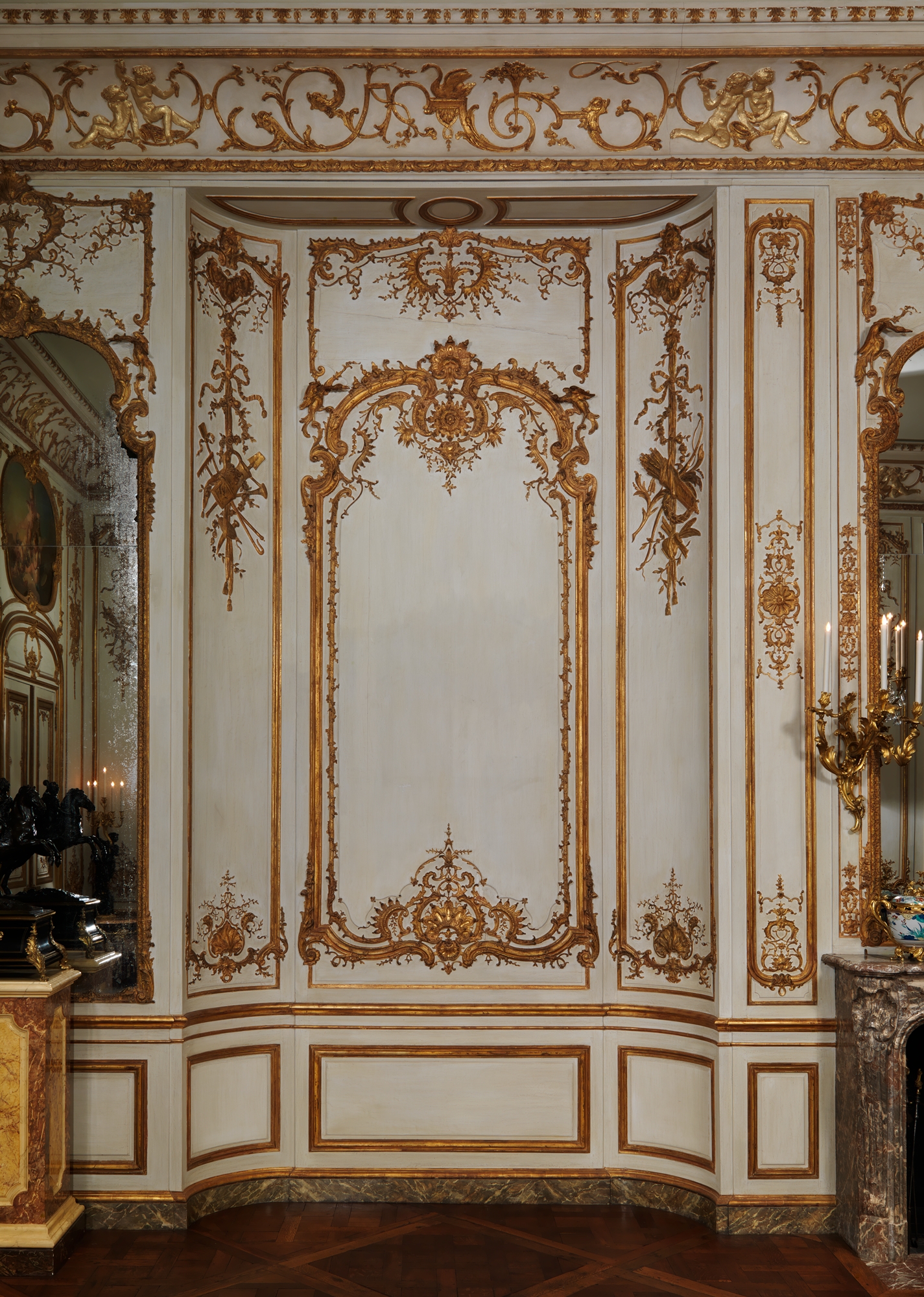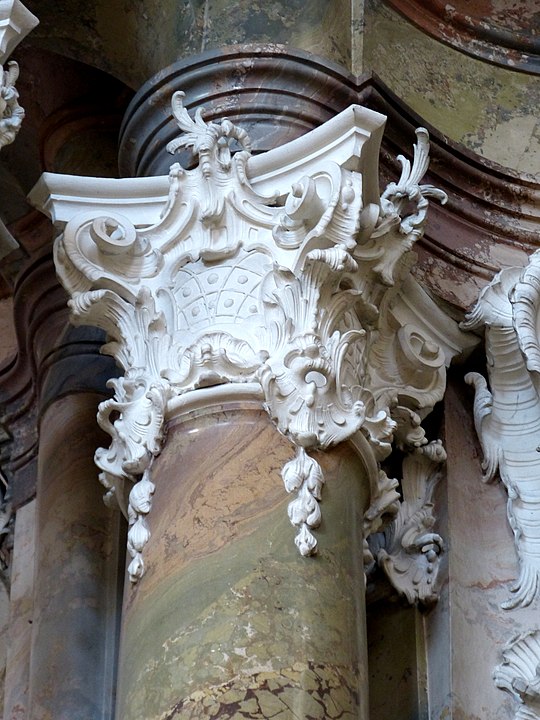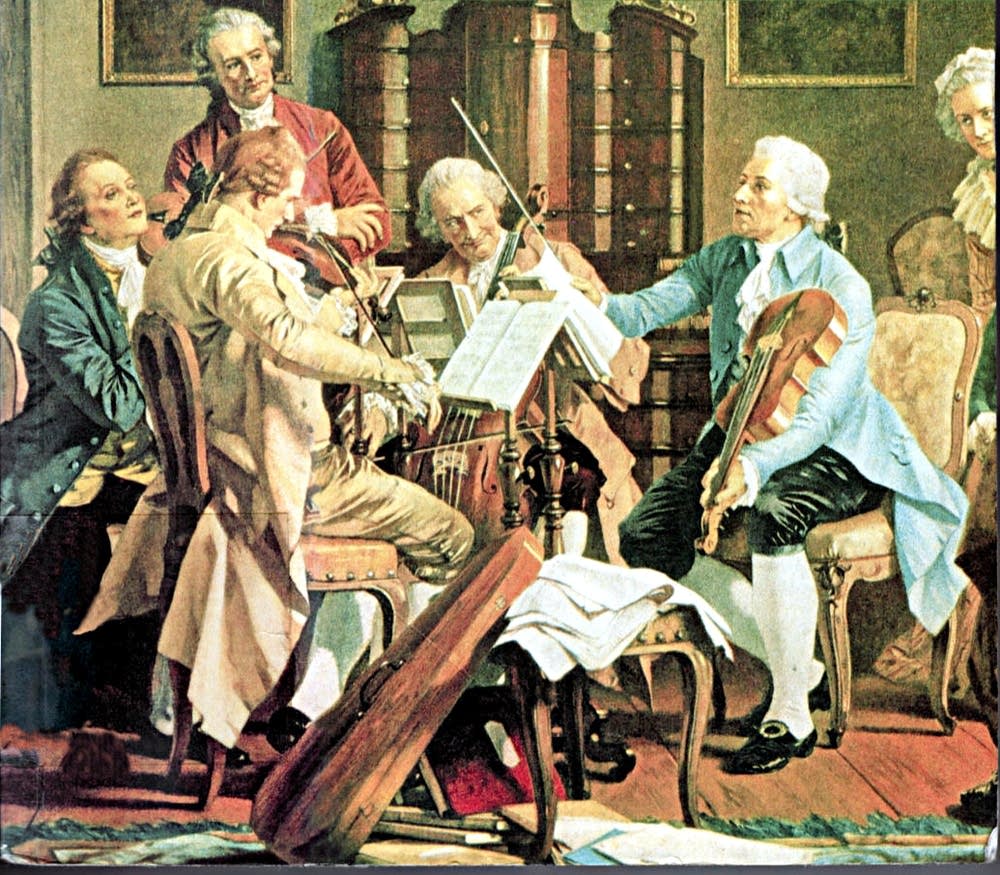(This is Part II of a three-part series by Dad Chwalyk titled "classical Music Every DeMolay Should Know!" continued from the previous "PART I: THE BAROQUE ERA.")
INTERMEZZO
Welcome back! As a quick review from Part I, "classical" (with a lowercase "c") is a term often used by non-musicians to refer to music from roughly 1600-1910, also known as the common practice era. Musicians and those who have seriously studied music (or read certain DeMolay articles), however, know that classical music is often divided into three distinct, shorter periods: Baroque (c. 1600-1750), Classical "with a capital 'C'" (c. 1730-1820), and Romantic (c.1800-1910). In the preceding article, you read about Baroque music, and while people often talk about classical music, now we can talk about Classical music! This is the period that begins at the height of European elegance, and includes several tumultuous wars and even the birth of a few nations (such as ours) before its close. As previously mentioned, there was a little bit of overlap between each of our three epochs, however, so let's start with that:
Welcome back! As a quick review from Part I, "classical" (with a lowercase "c") is a term often used by non-musicians to refer to music from roughly 1600-1910, also known as the common practice era. Musicians and those who have seriously studied music (or read certain DeMolay articles), however, know that classical music is often divided into three distinct, shorter periods: Baroque (c. 1600-1750), Classical "with a capital 'C'" (c. 1730-1820), and Romantic (c.1800-1910). In the preceding article, you read about Baroque music, and while people often talk about classical music, now we can talk about Classical music! This is the period that begins at the height of European elegance, and includes several tumultuous wars and even the birth of a few nations (such as ours) before its close. As previously mentioned, there was a little bit of overlap between each of our three epochs, however, so let's start with that:
THE ROCOCO
Unsurprisingly, the Rococo period is often glossed over when discussing the transition from Baroque to Classical music, since it only lasted about 20 years or so from the 1730s to the 1750s (with faint echoes still heard until the 1780s). It was important, nonetheless, in that it helped to pave the way for the next big musical era-to-be. Our story takes us to France in the years following the reign of Louis XIV, during whose kingship the Royal Academy of Painting and Sculpture and the Royal Academy of Architecture imposed rules on their artists so that their work would align with Baroque ideals. Symmetry, order, and formality were key components, but, with the old king out of the way and as artists are wont to do, its members grew tired of these restrictions, seeking to create new forms. What resulted was a different style, immediately recognizable by its elegant, exuberant decorations, intentional asymmetry, and floral, animal, and birdlike designs. Such notions quickly carried into everyday creation, such as furniture-making, so that even middle-class residents could afford small vestiges of the high life through this new trend, as demonstrated below by actual period pieces:

( A Rococo Chest of Drawers)


An example of Rococo Wall Decor
Churches and other oft-frequented buildings also got in on the action, as architectural trends in those days were important to follow so that people were enticed to visit:

In music, this era is evidenced by intimate melodies with much ornamentation, such as the work of slightly lesser-known composers like Jean Philippe Rameau, Louis-Claude Daquin, and François Couperin in France, and in Germany, C. P. E. Bach and Johann Christian Bach, two sons of the famous Johann Sebastian Bach, whose work and great influence we discussed in Part I.
PART II: THE CLASSICAL ERA (WITH A CAPITAL "C")

Reaction to the Rococo style, in turn, and not the Baroque era, created the demand for light, singable melodies that simply delighted. In other words, through this ongoing attempt to bring elegance to the everyman, fancy ornamentations and flowery phrases sharply declined in popularity, perpetuating the notion that one needn't be remotely rich or royal to have "class." Franz Joseph Haydn, Wolfgang Amadeus Mozart, and Ludwig van Beethoven are often considered the "big three" of this era, and they certainly didn't disappoint in terms of legacy or longevity. Anyone who has taken piano lessons or played in an orchestra will certainly recognize, in some way, these TEN CLASSICAL PIECES EVERY DeMOLAY SHOULD KNOW:
10.) Haydn: Symphony No. 94, H. 1/94 – 2nd Movement: Andante (https://www.youtube.com/
10.) Haydn: Symphony No. 94, H. 1/94 – 2nd Movement: Andante (https://www.youtube.com/
Also known as the "Surprise" symphony, this is probably the most famous of Haydn's "London Symphonies," so called because he wrote them while visiting there twice between 1791 and 1795. This one in particular was written during his first visit and is memorable for its "surprise" in the melody of the second movement, about 42 seconds into the recording linked above. Haydn uses violins to begin introducing the tune, then repeats the first phrase even softer, which is interrupted by a loud downbeat with the help of the entire rest of the orchestra. In its time, this was (forgive me) noteworthy; the orchestras of the Classical era were larger than those of the previous Baroque, often including more winds and percussion; to a 1791 audience, the shock of this "hit" would have been understandably delightful. This piece would add a touch of class to any chapter function without people falling asleep!
9.) Mozart: The Magic Flute, K. 620 – Act II, Scene iii, Der Hölle Rache kocht in meinum Herzen (https://youtu.be/QXHP5eV-mlA)
At forty-two seconds into this recording, you will no doubt start singing along in your head, because to do so out loud would probably not be very successful; this particular aria is known for its difficulty by even the most prolific sopranos! Also called the "Queen of the Night" aria (for the character singing it), Mozart wrote this 1791 blockbuster specifically for his sister-in-law, the renowned Josepha Hofer, as part of The Magic Flute, one of the composer's most famous operas of all time. This truly says something, considering Mozart started writing operas at the age of eleven, before he would even be able to join DeMolay today!
8.) Mozart: Serenade No. 13 for Strings in G Major, K. 525 – 1st Movement: Allegro (https://
You may also know this piece by its German moniker, Eine kleine Nachtmusik, or, more likely, its English translation ("A Little Night Music"). Widely regarded as Mozart's most popular and enduring piece, it is interesting to point out that this common subtitle comes from a note Mozart wrote for himself in his own catalogue to describe it. In other words, "A Little Night Music," as charming as it sounds, was not a title given to the work by the composer himself in 1787, but a quick reference so he would know which piece it was when looking back. (A more accurate translation might be "little serenade.") This alternative name refers to the entire piece and not just the movement we are discussing here, which is a prime example of the sonata-allegro form often studied by musicians at music school. Its remarkable longevity, earworm potential, and academic relevancy all give this ubiquitous tune a much-deserved spot on this list. Great for any positive occasion!
7.) Luigi Boccherini: String Quintet in E Major, Op. 11 No. 5 (G. 275) – 3rd Movement: Minuet (https://www.
The first piece on our list written before the end of the American Revolution (1771, published in 1775) is undoubtedly Boccherini's biggest and longest-lasting hit. Often used in movies and television shows to represent the upper class or elegant trappings of British high society in particular (sometimes ironically), this isn't too much of a stretch – the piece was written for the Font String Quartet, who were employed by Don Luis, brother of King Charles III of Spain. Boccherini himself sometimes joined the group on his cello, prompting him to write a 5th part and ultimately making the work a quintet. (As you can see, usages implying royalty or the aristocracy aren't wrong, they simply tend not to realize the work's Spanish associations.) Even by today's standards, Boccherini is not a "one-hit wonder," however – there is also his famous Musica notturna delle strade di Madrid which became popular through its frequent use in films such as Master and Commander: The Far Side of the World, and its use during the opening of the Barcelona 1992 Summer Olympic Games. (https://www.youtube.com/
6.) Mozart: Piano Sonata No. 11 in A Major, K. 331 (330i) – 3rd Movement: Alla turca – Allegretto (https://www.
It is no secret that the piano greatly increased in popularity during the Classical era, resulting in thousands of new piano works. Few, however, are as well known as this one. Written in rondo form, another form studied by musicians, this movement is sometimes called the "Rondo Alla Turca," although a more accurate title might be "Turkish March;" Mozart sought to emulate the sound of the visiting Turkish Janissary bands from the Ottoman Empire that were popular in his native homeland of Austria, and if it can be said that these were the first "military bands," then Mozart's memorable 1783 ditty here is certainly the first known piano version of a "military march." It's a little tough to play, so put this on the same playlist as Eine kleine Nachtmusik to add some Mozart to a festive evening, unless your chapter has access to a proficient pianist!
5.) Beethoven: Bagatelle No. 25 in A minor, WoO 59 (https://www.youtube.com/
Immensely popular with piano students, teachers, and enthusiasts alike, "Für Elise" was not discovered until 35 years after Beethoven's death and was published posthumously. No one knows who "Elise" is, though there is speculation that the name belonged to one of his piano students. This piece is typically used as an etude, or learning piece, for beginners; the first and best-known section is fairly simple and straightforward, with the middle section being more technical and difficult to perform well, even more so than the famous "Moonlight Sonata" movement also ranked here:
4.) Beethoven: Piano Sonata No. 14 in C# minor "Quasi una fantasia" Op. 27, No. 2 – 1st Movement: Adagio Sostenuto (https://www.
As with Für Elise, Beethoven did not give this piece its title we are so familiar with today. "Moonlight Sonata" was a descriptor used by a critic to praise the work after Beethoven's death. It is also worth noting that the piece was just as popular in Beethoven's day as it is now – a rare instance of a work that received equal appreciation in its own time. Beethoven's work in general is often considered a "bridge" between the Classical and Romantic eras; while his melodies are simple in construction, his use of dissonance and less predictable harmonies are quite evocative compared to his contemporaries. The Moonlight Sonata is a sublime example of this, as its indelible and transcendent expressions can not easily be overlooked.
Coincidentally, if any of your chapter members seriously play the piano, both "Für Elise" and the first movement of the "Moonlight Sonata" would be great classical (and Classical) requests! (Perhaps for extinguishing the candles when closing?)
3.) Beethoven: Symphony No. 5, Op. 67 – 1st Movement: Allegro con brio (https://www.youtube.com/
The first four notes are unmistakable; the rest is unassailable. It has been said that the initial motif that develops and winds its way through this piece is the most recognizable in Western music. The symphony as a whole took Beethoven four years of on-and-off work to complete, from 1804-1808. Also in sonata-allegro form, this movement is often studied in depth by students looking to Beethoven for advice on how to compose and orchestrate a significant work from just a single fragment or idea. Feel free to "conduct" this one on your own for a thrilling experience... and such drama!
2.) Mozart/Süssmayr: Requiem in D minor, K. 626 – Section III: Sequentia, Part f. Lacrimosa (https://www.
Mozart only lived until he was 35 years old. Considering the number of outstanding pieces he wrote (and not just the ones on this list), it is heartbreaking to imagine the incredible music that he would have no doubt continued to create had he lived another 35 years or more. Sadly, death comes to us all, and requiems are one of the most solemn types of ceremonial music known to come out of the great composers. These pieces are meant to be used during the Catholic funeral mass, and many contain beautiful and emotionally stirring melodies. This selection would be immortalized as the final music Mozart wrote, only completing the first eight bars or so of the Lacrimosa before he passed away on December 5, 1791, with the rest ultimately completed by a contemporary, Franz Xaver Süssmayr, at the request of Mozart's widow Constanze. Fittingly, lacrimosa means "weeping" in Latin, and the powerful melancholy this piece lulls us into when reflecting upon the untimely death of its composer is one of the saddest and most tragic coincidences in the history of music, leaving to Mozart this tribute begun in his very own hand.
1.) Beethoven: Symphony No. 9 in D minor, Op. 125 – 4th Movement: Finale
Full Movement: https://www.youtube.
Beginning at orchestral "Ode to Joy" section: https://www.youtube.
Beginning at vocal "Ode to Joy" section: https://www.youtube.
Final ending: https://youtu.be/
The longest and most complex work written by a Classical composer, Beethoven's 9th and final symphony is legendary and deserving of our top spot for many reasons:
According to various letters obtained by historians, Beethoven began experiencing "buzzing" in his ears around 1796, when he was just 25 years old. A partial hearing loss was detectable by 1798, and by 1801, he had lost approximately 60% of this sacred sense. His condition would continue to deteriorate over the next 15-20 years, and by his 50s, Beethoven would be considered completely deaf. Increasingly unable to hear, he had already cut the legs off of his piano and clenched his teeth around a stick while he played sitting on the floor. Thus he would use the vibrations he perceived as well as his memory of the piano keys to connect to musical pitches in ways his ears no longer could. His entire 9th symphony would be composed in this manner.
Musically speaking, the work is unique in that it employed a huge orchestra – even by today's standards – calling for not only the usual array of string instruments or the "new normal" additions of woodwinds and brass instruments with multiple percussionists, but it also demands four vocal soloists and a full concert choir! This was the first time in history a composer would combine a full chorus with a symphony orchestra in a concert setting, even though the singers do not join the performance until the final movement discussed here. (And speaking as someone who has sung it before, sitting perfectly still on stage and waiting the 45+ minutes before having to sing in 18th-century German requires a great deal of patience and a certain conscious control of whatever anxiety the music produces before you!)
The lyrics are taken from a 1785 poem by Friedrich Stiller, written in German and translated into English as "Ode to Joy," hence this movement's common name today. Beethoven had not done much vocal writing in comparison to his instrumental output, and frequently doubted his ability to write for voice, once remarking, "When sound stirs within me I always hear the full orchestra; I know what to expect of instrumentalists, who are capable of almost everything, but with vocal composition I must always be asking myself: can this be sung?". The fact that he was able to set Stiller's poem using complex counterpoint and text painting for not only orchestra but voices(!) when considering these doubts, compounded by the profound deafness he was experiencing at this stage of his life, is truly awe-inspiring when one hears the result.
The 9th Symphony was premiered in 1824*, and while Beethoven did not conduct it, he stood on stage beating time, though the musicians were told to ignore him. When the entire symphony ended, Beethoven was unaware of the thunderous applause that filled the Vienna theater until, the story goes, the conductor turned him around to witness a standing ovation!
* This was Beethoven's first onstage appearance in 12 years, and four years past the "cutoff date" for the Classical era enshrined in the history books and this article, proving that Beethoven, deaf and well into his 50s, was helping to single-handedly move music into the next era with his influence, a force not to be reckoned with. And while he cast aspersions at the new music he was hearing (or not) during the overlap with our next era, he unknowingly contributed to it with his own musical voice, particularly his romanticization of Stiller's poem, which contained lines that could not be more fitting for a fraternity:
Thy enchantments bind together,
What did custom stern divide,
Every man becomes a brother,
Where thy gentle wings abide.
What did custom stern divide,
Every man becomes a brother,
Where thy gentle wings abide.
"Stay tuned" for Part III!
Dad James Chwalyk is a Senior DeMolay and the Director of Scholarships (formerly Director of Education) for New Jersey DeMolay. He is also a full-time music teacher and professional musician. Dad Chwalyk can be reached via email at james.chwalyk.jr@gmail.com

